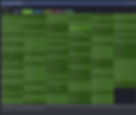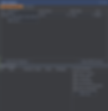Simple Drum Lights Setup
- AJK
- Mar 25, 2024
- 7 min read
Updated: Apr 2, 2024
First, you have to have the following ingredients.
A Drum
A Drum Trigger
A Quarter inch cable
An SPD-SX or a drum brain, something to take in the trigger signal and output midi
USB Cable for SPD-SX to computer
Laptop
A USB DMX interface and appropriate converters
An XLR cable
A DMX capable light
Full transparency: This link contains all of the items that I am using. Through the amazon affiliate system, I may earn a small commission if you decide to purchase through this link
The hard part: Creating a MIDI-DMX patch
Intro to Touchdesigner
Touchdesigner is a visual programming environment aimed at the creation of multimedia applications.

Controls
Getting around, the main window can be moved around by left clicking and dragging the mouse.
The middle mouse button zooms.
Right click to bring up sub menus for supported elements.
Adding Operators: The basic way to add an operator is to press tab to bring up the OP Create Dialog and select the operator.

You can press the tab key again to move through the different pages, start typing to search for an operator. There are different containers and operators that each have a unique function.
CHOPS = Channel Operators
TOPS = Texture Operators
SOPS=Shape operators
MATS=Material Operators
DATS= Data Operators
You don’t need to know much about all of them now, by building different things, you can uncover the function for each one.
Just know that on the left side of the window for each operator are the inputs, and on the right side are the outputs.

Theory for simple LED drums
We are taking advantage of 2 protocols here MIDI and DMX
DMX or DMX512, stands for “Digital Multiplex with 512 pieces of information.”

It is a standard developed in the 80s in the US after theaters found it different to manage a number of different protocols.
DMX Data is organized by channel which can receive a value from 0-127, 512 channels makes up 1 universe.
MIDI is standard to transmit and store music, originally designed for digital music synthesizers
It was developed in the 1980s as electronic instruments became more popular, and they needed a way to talk to each other.
MIDI 2.0 is an 8-bit system that can output up to 16 channels. There are many types of messages that can be communicated to tell the software how the instrument should be played like note pressure, pitch bend, hi hat controller position, etc.) It gets complex but each channel can receive a velocity value from 0-127.
Both of these standards use base 0 counting, so we include 0 to say that there are 128 possible values. Now that we have a basis for the technology let’s talk about how we are going to use the software to convert one data type into another.
First we need the MIDI data to enter the software. Press tab and navigate to the CHOPS panel

Select the MIDI Device in CHOP

You may notice the icon telling us something is wrong. you can click it over it for more information

The issue here is that TouchDesginer does not automatically detect MIDI Devices like a lot of other software.
After connecting the SPD to the computer with the USB cable

We need to add it in the midi device manager located at the top bar under Dialogues After opening the window create a new midi device mapping

From there you want to add your SPD-SX to the device manager. Note- there may be 2 devices listed in the manager. You may need to toggle between them to see which one is active. Here I don’t have the SPD plugged in but you get the idea.

To test for signal, keep the dialogue window open and press a MIDI pad, if it is connected properly, you will see a new message in the window. Once it is connected, you should see new midi information show up in the chop window

You may see nothing at all, in which case, start with the simplest thing first and work up to more complex solutions. Make sure you have the SPD-SX Drivers
If it's working properly, when you hit your drum you should see something like this.

From there we need to consider our light. Its important to read the manual, save a copy, or to make sure it is easily accessible for your light, as this information is crucial to controlling it properly. For example my light uses 7 channels of DMX to control its functions:

CH1: Brightness
CH2: RED level
CH3: Green Level
CH4: Blue Level
CH5: Strobe speed, the bigger the value, the faster the strobe
CH6: Chase, an automation of the light that allows it to change colors automatically
CH7: Chase speed, controls the speed of the chase.
Your light may only have 3 channels, Red, Green, and Blue, you have to mix values to change the intensity of the colors.
Some lights are additive RGBW (Red, Green, Blue, White) or have a subtractive CMYK (Cyan, Magenta, Yellow, Key [black]) color mixing setup.
Now that we know what the channels are, we can choose to affect them manually to test our DMX signal
Press tab, create a “Constant” CHOP.

The constant allows us to set values that remain constant. We are emulating the faders on a DMX board. There are little sliders next to each channel. The sliders by default range from 0-1. Within the CHOP create 7 channels by pressing the plus button


Next, make a Math CHOP, the math CHOP has a function panel called range which allows you to remap values.
To Connect 2 of the same operator, click and drag from the black box on the right end end of one operator to the left side of the


For this example the range 0-1 for the constant chop sliders will have to be remapped to 0-127 for the lights to speak the same language. First click on the Range tab in the properties window.

Type 127 in the second box of the “To Range” in order to expand 0-1 to 0-127
Now the computer will do the math so that if the slider is at 0.5, the math chop will output 64, which is half of 128.
DMX Output
Press tab, add a DMX out chop, select your DMX interface under device.

Connect the math chop to the DMX chop.
Address the DMX light: Each light has a different way to adjust its settings, on my particular light, it has a menu, up, down and enter button.
Optional material: Some DMX lights have different modes which may includeDMX mode, might show a lower case d as the indicator
Color Mode: Select a static color by changing the number, the light won’t change
Shade: transition through different colors continuously, you can adjust the speed of the color changing
Pulse: Transition through colors where they fade on and off, the speed can be changed
Transition: The lights cut from one color to the next, the speed of the transition can be changed
Flash: The light will strobe on and off quickly, you can change the speedSound: Here, the light changes with the use of a tiny onboard microphone, not creepy at all.
R,G,B, mode: Set the exact static color you want by mixing red green and blue.
DMX Mode:For my light, the DMX channel listing is as follows, be sure to read the manual to see if the same applies to your light. For my light to be “Addressed” to a DMX channel, I have to hit the menu button until a small d appears on the screen. From there the light takes 7 DMX channels for it’s different parameters. If I set the DMX address to 1, the channel list is as follows.
Master Brightness
Red light brightness
Green Light Brightness
Blue light brightness
Strobe
Chases, (Color, Pulse, transition, sound control on and off)
Color selection/color shade control.
Again, your light may differ, but I am setting it to DMX mode and assigning it channels 1-7 to control it. We are really only interested in a couple of the values for now. We can test the DMX output from touch designer by adjusting the sliders from the constant chop, to see if they are affecting the light.
Make sure your USB-DMX interface is connected, and the light is on, connected via XLR adapter and receiving power.
The device should be plug and play on windows, but you may need to install the device drivers. In some rare cases, the computer may not see your device at all. This is extremely frustrating, because it can be difficult to diagnose. You can try to go to the manufacturers website and see if they have any trouble shooting steps, or in my case. I was able to get it working on one computer, but not the second one. How weird.
On the constant chop, make sure the brightness master slider is all the way up, in this case channel 1
From there set 2,3, or 4 up to mix the Red green and blue values to make different colors.
Now that we have midi and DMX we can get one to control the other.
From the MIDI in chop, we “Export” the value coming in on the channel we see when we strike the desired drum pad. If you have everything set up correctly, you should be able to see the signal coming into the MIDI in Chop
Press the button in the bottom right corner of the chop to turn on it’s export mode.
Exporting basically takes the number that one channel is producing and it assigns it to the parameter of your choice. Here we can take that midi channel and assign it to the master brightness control value by clicking and dragging the channel and dropping it on the box for the value you want to change.
This allows us to control the colors as we like, but for the actual midi trigger to drive the brightness without us having to do anything manually.
Now when you hit the drum, you should see the MIDI signal bounce, in turn, making the DMX slider bounce, and what do you get? A light that responds to the midi trigger! This is an extremely simplified setup, but using this as a foundation, we can learn the fundamentals for more complex setups.
Thanks for reading
If you have any questions, feel free to reach out in the stick with it discord. Here are some links for further reading if you are interested in learning more: Touch Designer Documentation
